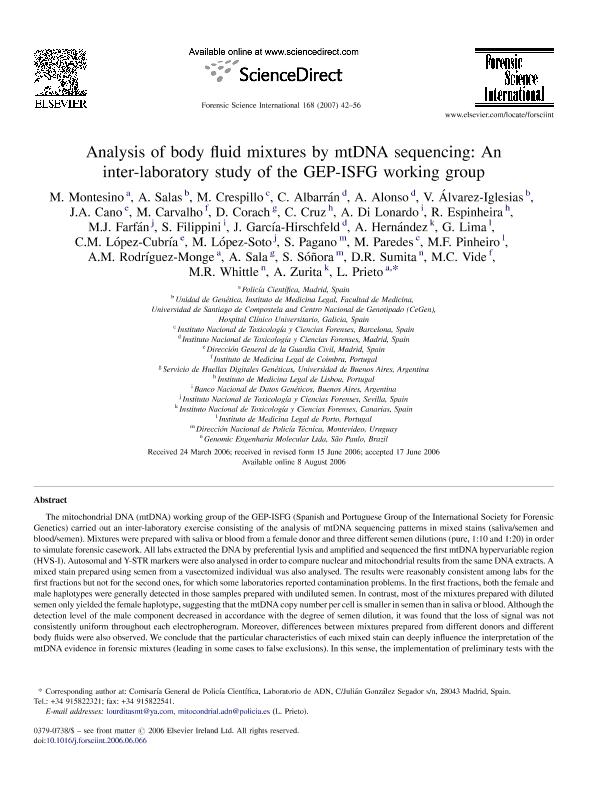Artículo
Analysis of body fluid mixtures by mtDNA sequencing: An inter-laboratory study of the GEP-ISFG working group
Montesino, M.; Sala, Adriana Andrea ; Crespillo, M.; Albarrán, C.; Alonso, A.; Álvarez Iglesias, V.; Cano, J. A.; Carvalho, M.; Corach, Daniel
; Crespillo, M.; Albarrán, C.; Alonso, A.; Álvarez Iglesias, V.; Cano, J. A.; Carvalho, M.; Corach, Daniel ; Cruz, C.; Di Lonardo, A.; Espinheira, R.; Farfán, M. J.; Filippini, S.; García Hirschfeld, J.; Hernández, A.; Lima, G.; López Cubría, C. M.; López Soto, M.; Pagano, S.; Paredes, M.; Pinheiro, M. F.; RodríguezMonge, A. M.; Sala, A.; Sóñora, S.; Sumita, D. R.; Vide, M. C.; Whittle, M. R.; Zurita, A.; Prieto, L.
; Cruz, C.; Di Lonardo, A.; Espinheira, R.; Farfán, M. J.; Filippini, S.; García Hirschfeld, J.; Hernández, A.; Lima, G.; López Cubría, C. M.; López Soto, M.; Pagano, S.; Paredes, M.; Pinheiro, M. F.; RodríguezMonge, A. M.; Sala, A.; Sóñora, S.; Sumita, D. R.; Vide, M. C.; Whittle, M. R.; Zurita, A.; Prieto, L.
 ; Crespillo, M.; Albarrán, C.; Alonso, A.; Álvarez Iglesias, V.; Cano, J. A.; Carvalho, M.; Corach, Daniel
; Crespillo, M.; Albarrán, C.; Alonso, A.; Álvarez Iglesias, V.; Cano, J. A.; Carvalho, M.; Corach, Daniel ; Cruz, C.; Di Lonardo, A.; Espinheira, R.; Farfán, M. J.; Filippini, S.; García Hirschfeld, J.; Hernández, A.; Lima, G.; López Cubría, C. M.; López Soto, M.; Pagano, S.; Paredes, M.; Pinheiro, M. F.; RodríguezMonge, A. M.; Sala, A.; Sóñora, S.; Sumita, D. R.; Vide, M. C.; Whittle, M. R.; Zurita, A.; Prieto, L.
; Cruz, C.; Di Lonardo, A.; Espinheira, R.; Farfán, M. J.; Filippini, S.; García Hirschfeld, J.; Hernández, A.; Lima, G.; López Cubría, C. M.; López Soto, M.; Pagano, S.; Paredes, M.; Pinheiro, M. F.; RodríguezMonge, A. M.; Sala, A.; Sóñora, S.; Sumita, D. R.; Vide, M. C.; Whittle, M. R.; Zurita, A.; Prieto, L.
Fecha de publicación:
05/2007
Editorial:
Elsevier Ireland
Revista:
Forensic Science International
ISSN:
0379-0738
Idioma:
Inglés
Tipo de recurso:
Artículo publicado
Clasificación temática:
Resumen
The mitochondrial DNA (mtDNA) working group of the GEP-ISFG (Spanish and Portuguese Group of the International Society for Forensic Genetics) carried out an inter-laboratory exercise consisting of the analysis of mtDNA sequencing patterns in mixed stains (saliva/semen and blood/semen). Mixtures were prepared with saliva or blood from a female donor and three different semen dilutions (pure, 1:10 and 1:20) in order to simulate forensic casework. All labs extracted the DNA by preferential lysis and amplified and sequenced the first mtDNA hypervariable region (HVS-I). Autosomal and Y-STR markers were also analysed in order to compare nuclear and mitochondrial results from the same DNA extracts. A mixed stain prepared using semen from a vasectomized individual was also analysed. The results were reasonably consistent among labs for the first fractions but not for the second ones, for which some laboratories reported contamination problems. In the first fractions, both the female and male haplotypes were generally detected in those samples prepared with undiluted semen. In contrast, most of the mixtures prepared with diluted semen only yielded the female haplotype, suggesting that the mtDNA copy number per cell is smaller in semen than in saliva or blood. Although the detection level of the male component decreased in accordance with the degree of semen dilution, it was found that the loss of signal was not consistently uniform throughout each electropherogram. Moreover, differences between mixtures prepared from different donors and different body fluids were also observed. We conclude that the particular characteristics of each mixed stain can deeply influence the interpretation of the mtDNA evidence in forensic mixtures (leading in some cases to false exclusions). In this sense, the implementation of preliminary tests with the aim of identifying the fluids involved in the mixture is an essential tool. In addition, in order to prevent incorrect conclusions in the interpretation of electropherograms we strongly recommend: (i) the use of additional sequencing primers to confirm the sequencing results and (ii) interpreting the results to the light of the phylogenetic perspective.
Palabras clave:
HAPLOTYPE
,
HVS-I
,
MTDNA MIXTURE
,
MTDNA PHYLOGENY
,
PREFERENTIAL LYSIS
,
SEQUENCING
Archivos asociados
Licencia
Identificadores
Colecciones
Articulos(OCA HOUSSAY)
Articulos de OFICINA DE COORDINACION ADMINISTRATIVA HOUSSAY
Articulos de OFICINA DE COORDINACION ADMINISTRATIVA HOUSSAY
Citación
Montesino, M.; Sala, Adriana Andrea; Crespillo, M.; Albarrán, C.; Alonso, A.; et al.; Analysis of body fluid mixtures by mtDNA sequencing: An inter-laboratory study of the GEP-ISFG working group; Elsevier Ireland; Forensic Science International; 168; 1; 5-2007; 42-56
Compartir
Altmétricas



